Oil SKODA SUPERB 2003 1.G / (B5/3U) Owner's Guide
[x] Cancel search | Manufacturer: SKODA, Model Year: 2003, Model line: SUPERB, Model: SKODA SUPERB 2003 1.G / (B5/3U)Pages: 259
Page 200 of 259
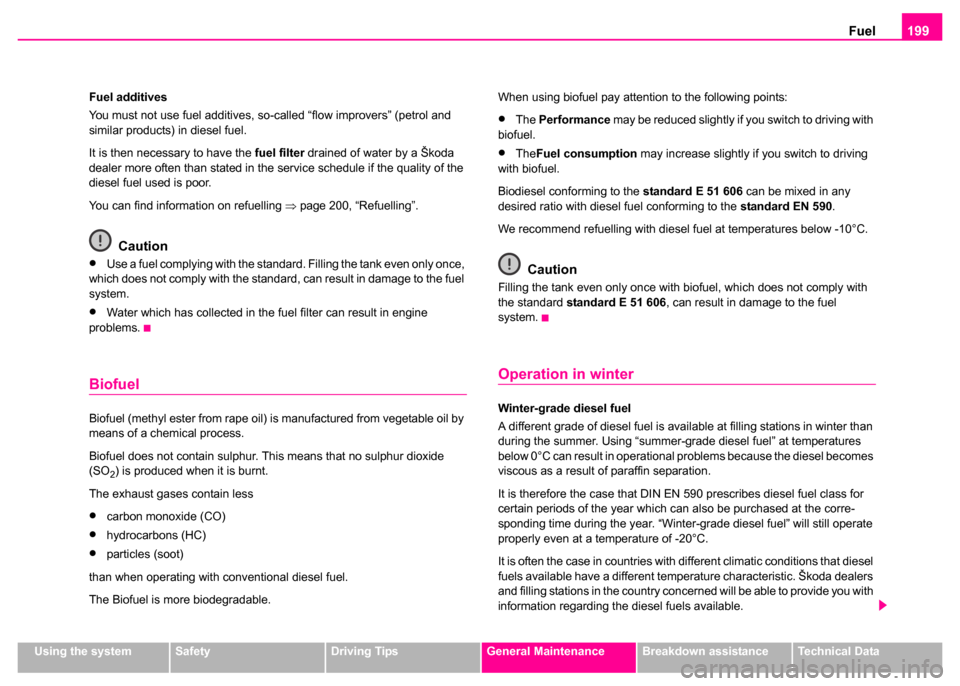
Fuel199
Using the systemSafetyDriving TipsGeneral MaintenanceBreakdown assistanceTechnical Data
Fuel additives
You must not use fuel additives, so-called “flow improvers” (petrol and
similar products) in diesel fuel.
It is then necessary to have the
fuel filter drained of water by a Škoda
dealer more often than stated in the service schedule if the quality of the
diesel fuel used is poor.
You can find information on refuelling ⇒page 200, “Refuelling”.
Caution
•Use a fuel complying with the standard. Filling the tank even only once,
which does not comply with the standard, can result in damage to the fuel
system.
•Water which has collected in the fuel filter can result in engine
problems.
Biofuel
Biofuel (methyl ester from rape oil) is manufactured from vegetable oil by
means of a chemical process.
Biofuel does not contain sulphur. This means that no sulphur dioxide
(SO
2) is produced when it is burnt.
The exhaust gases contain less
•carbon monoxide (CO)
•hydrocarbons (HC)
•particles (soot)
than when operating with conventional diesel fuel.
The Biofuel is more biodegradable. When using biofuel pay attention to the following points:
•The
Performance may be reduced slightly if you switch to driving with
biofuel.
•The Fuel consumption may increase slightly if you switch to driving
with biofuel.
Biodiesel conforming to the standard E 51 606 can be mixed in any
desired ratio with diesel fuel conforming to the standard EN 590.
We recommend refuelling with diesel fuel at temperatures below -10°C.
Caution
Filling the tank even only once with biofuel, which does not comply with
the standard standard E 51 606 , can result in damage to the fuel
system.
Operation in winter
Winter-grade diesel fuel
A different grade of diesel fuel is available at filling stations in winter than
during the summer. Using “summer-grade diesel fuel” at temperatures
below 0°C can result in operational problems because the diesel becomes
viscous as a result of paraffin separation.
It is therefore the case that DIN EN 590 prescribes diesel fuel class for
certain periods of the year which can also be purchased at the corre-
sponding time during the year. “Winter-grade diesel fuel” will still operate
properly even at a temperature of -20°C.
It is often the case in countries with different climatic conditions that diesel
fuels available have a different temperature characteristic. Škoda dealers
and filling stations in the country concerned will be able to provide you with
information regarding the diesel fuels available.
Page 204 of 259
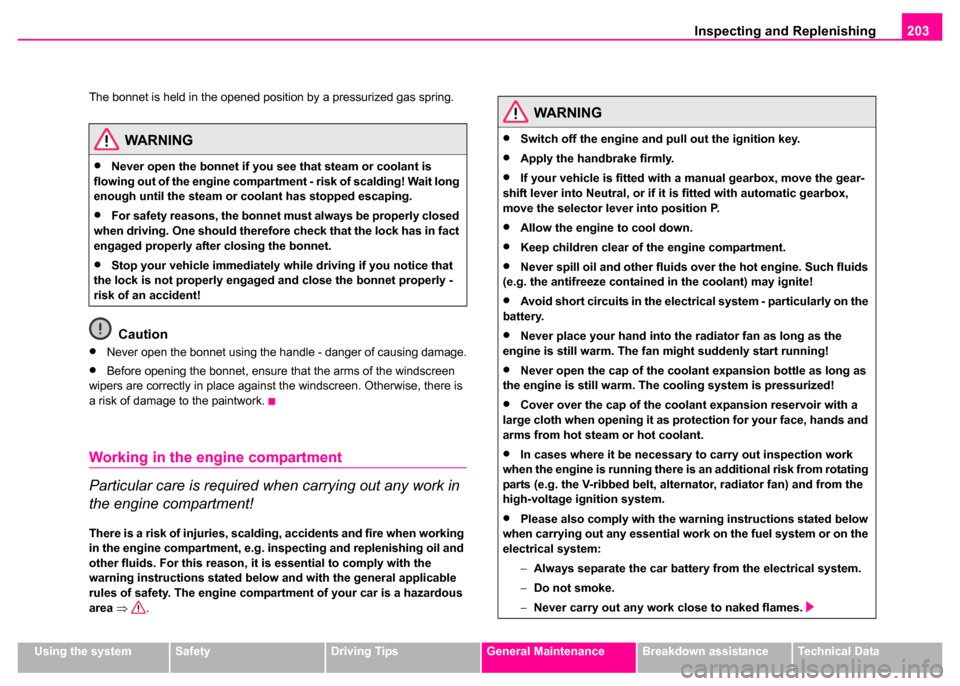
Inspecting and Replenishing203
Using the systemSafetyDriving TipsGeneral MaintenanceBreakdown assistanceTechnical Data
The bonnet is held in the opened position by a pressurized gas spring.
Caution
•Never open the bonnet using the handle - danger of causing damage.
•Before opening the bonnet, ensure that the arms of the windscreen
wipers are correctly in place against the windscreen. Otherwise, there is
a risk of damage to the paintwork.
Working in the en gine compartment
Particular care is required when carrying out any work in
the engine compartment!
There is a risk of injuries, scalding , accidents and fire when working
in the engine compartment, e.g. inspecting and replenishing oil and
other fluids. For this reason, it is essential to comply with the
warning instructions st ated below and with the general applicable
rules of safety. The engine compartment of your car is a hazardous
area ⇒ .
WARNING
•Never open the bonnet if you see that steam or coolant is
flowing out of the engine compartmen t - risk of scalding! Wait long
enough until the steam or coolant has stopped escaping.
•For safety reasons, the bonnet must always be properly closed
when driving. One should therefore check that the lock has in fact
engaged properly after closing the bonnet.
•Stop your vehicle immediately wh ile driving if you notice that
the lock is not properly engaged and close the bonnet properly -
risk of an accident!
WARNING
•Switch off the engine and pull out the ignition key.
•Apply the handbrake firmly.
•If your vehicle is fitted with a manual gearbox, move the gear-
shift lever into Neutral, or if it is fitted with automatic gearbox,
move the selector lever into position P.
•Allow the engine to cool down.
•Keep children clear of the engine compartment.
•Never spill oil and other fluids over the hot engine. Such fluids
(e.g. the antifreeze contained in the coolant) may ignite!
•Avoid short circuits in the electrical system - particularly on the
battery.
•Never place your hand into the radiator fan as long as the
engine is still warm. The fan might suddenly start running!
•Never open the cap of the coolant expansion bottle as long as
the engine is still warm. The cooling system is pressurized!
•Cover over the cap of the coolant expansion reservoir with a
large cloth when opening it as protection for your face, hands and
arms from hot steam or hot coolant.
•In cases where it be necessary to carry out inspection work
when the engine is running there is an additional risk from rotating
parts (e.g. the V-ribbed belt, alternator, radiator fan) and from the
high-voltage ignition system.
•Please also comply with the warning instructions stated below
when carrying out any essential work on the fuel system or on the
electrical system:
−Always separate the car battery from the electrical system.
− Do not smoke.
− Never carry out any work close to naked flames.
Page 205 of 259
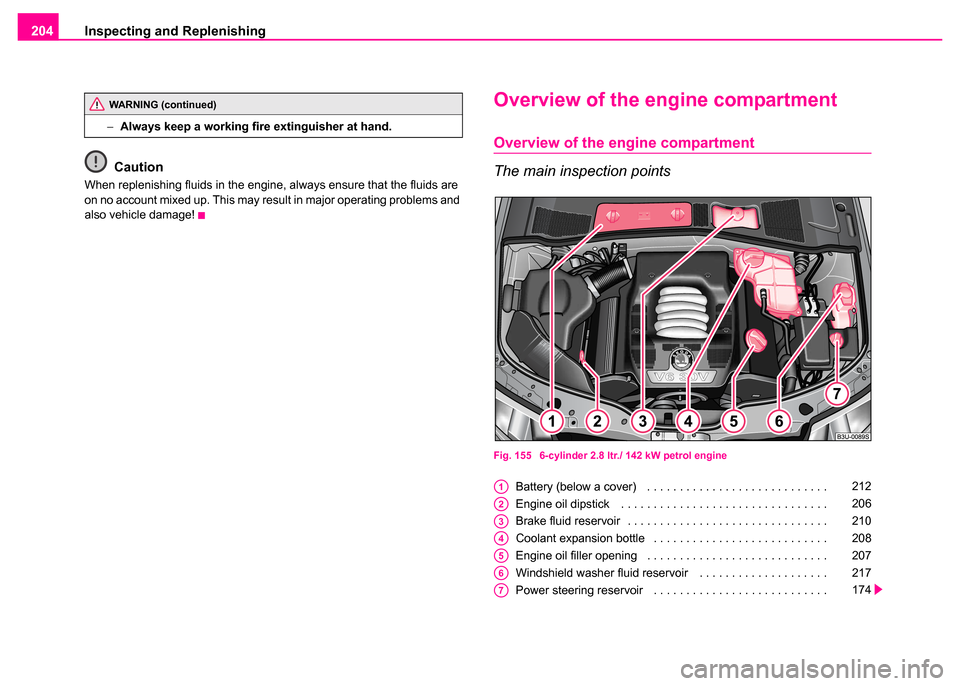
Inspecting and Replenishing
204
Caution
When replenishing fluids in the engine, always ensure that the fluids are
on no account mixed up. This may result in major operating problems and
also vehicle damage!
Overview of the engine compartment
Overview of the engine compartment
The main inspection points
Fig. 155 6-cylinder 2.8 ltr./ 142 kW petrol engine
Battery (below a cover) . . . . . . . . . . . . . . . . . . . . . . . . . . . .
Engine oil dipstick . . . . . . . . . . . . . . . . . . . . . . . . . . . . . . . .
Brake fluid reservoir . . . . . . . . . . . . . . . . . . . . . . . . . . . . . . .
Coolant expansion bottle . . . . . . . . . . . . . . . . . . . . . . . . . . .
Engine oil filler opening . . . . . . . . . . . . . . . . . . . . . . . . . . . .
Windshield washer fluid reservoir . . . . . . . . . . . . . . . . . . . .
Power steering reservoir . . . . . . . . . . . . . . . . . . . . . . . . . . .
WARNING (continued)
−Always keep a working fire extinguisher at hand.
A1212
A2206
A3210
A4208
A5207
A6217
A7174
Page 206 of 259
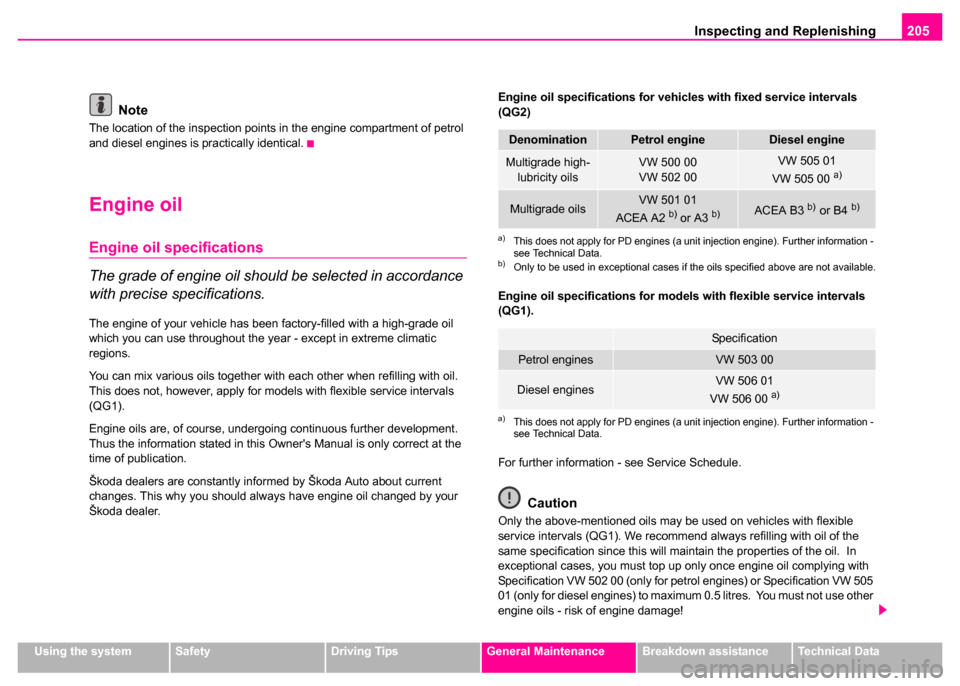
Inspecting and Replenishing205
Using the systemSafetyDriving TipsGeneral MaintenanceBreakdown assistanceTechnical Data
Note
The location of the inspection points in the engine compartment of petrol
and diesel engines is practically identical.
Engine oil
Engine oil specifications
The grade of engine oil should be selected in accordance
with precise specifications.
The engine of your vehicle has been factory-filled with a high-grade oil
which you can use throughout the year - except in extreme climatic
regions.
You can mix various oils together with each other when refilling with oil.
This does not, however, apply for models with flexible service intervals
(QG1).
Engine oils are, of course, undergoing continuous further development.
Thus the information stated in this Owner's Manual is only correct at the
time of publication.
Škoda dealers are constantly informed by Škoda Auto about current
changes. This why you should always have engine oil changed by your
Škoda dealer. Engine oil specifications for vehicles with fixed service intervals
(QG2)
Engine oil specifications for models with flexible service intervals
(QG1).
For further information - see Service Schedule.
Caution
Only the above-mentioned oils may be used on vehicles with flexible
service intervals (QG1). We recommend always refilling with oil of the
same specification since this will maintain the properties of the oil. In
exceptional cases, you must top up only once engine oil complying with
Specification VW 502 00 (only for petrol engines) or Specification VW 505
01 (only for diesel engines) to maximum 0.5 litres. You must not use other
engine oils - risk of engine damage!
DenominationPetrol engineDiesel engine
Multigrade high-
lubricity oilsVW 500 00
VW 502 00VW 505 01
VW 505 00 a)
a)This does not apply for PD engines (a unit injection engine). Further information -
see Technical Data.
Multigrade oilsVW 501 01
ACEA A2 b) or A3 b)
b)Only to be used in exceptional cases if the oils specified above are not available.
ACEA B3 b) or B4 b)
Specification
Petrol enginesVW 503 00
Diesel enginesVW 506 01
VW 506 00 a)
a)This does not apply for PD engines (a unit injection engine). Further information -
see Technical Data.
Page 207 of 259
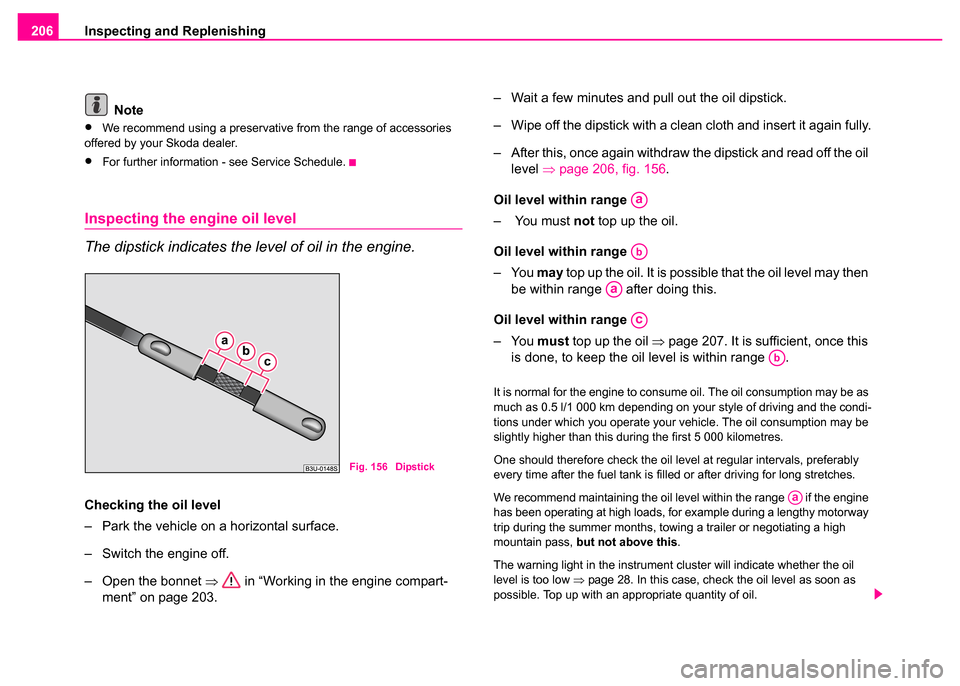
Inspecting and Replenishing
206
Note
•We recommend using a preservative from the range of accessories
offered by your Skoda dealer.
•For further information - see Service Schedule.
Inspecting the engine oil level
The dipstick indicates the level of oil in the engine.
Checking the oil level
– Park the vehicle on a horizontal surface.
– Switch the engine off.
– Open the bonnet ⇒ in “Working in the engine compart-
ment” on page 203. – Wait a few minutes and pull out the oil dipstick.
– Wipe off the dipstick with a clean cloth and insert it again fully.
– After this, once again withdraw the dipstick and read off the oil
level ⇒page 206, fig. 156 .
Oil level within range
– You must not top up the oil.
Oil level within range
–You may top up the oil. It is possible that the oil level may then
be within range after doing this.
Oil level within range
–You must top up the oil ⇒page 207. It is sufficient, once this
is done, to keep the oil level is within range .
It is normal for the engine to consume oil. The oil consumption may be as
much as 0.5 l/1 000 km depending on your style of driving and the condi-
tions under which you operate your vehicle. The oil consumption may be
slightly higher than this during the first 5 000 kilometres.
One should therefore check the oil level at regular intervals, preferably
every time after the fuel tank is filled or after driving for long stretches.
We recommend maintaining the oil level within the range if the engine
has been operating at high loads, for example during a lengthy motorway
trip during the summer months, towing a trailer or negotiating a high
mountain pass, but not above this .
The warning light in the instrument cluster will indicate whether the oil
level is too low ⇒page 28. In this case, check the oil level as soon as
possible. Top up with an appropriate quantity of oil.
Fig. 156 Dipstick
Aa
Ab
Aa
Ac
Ab
Aa
Page 208 of 259
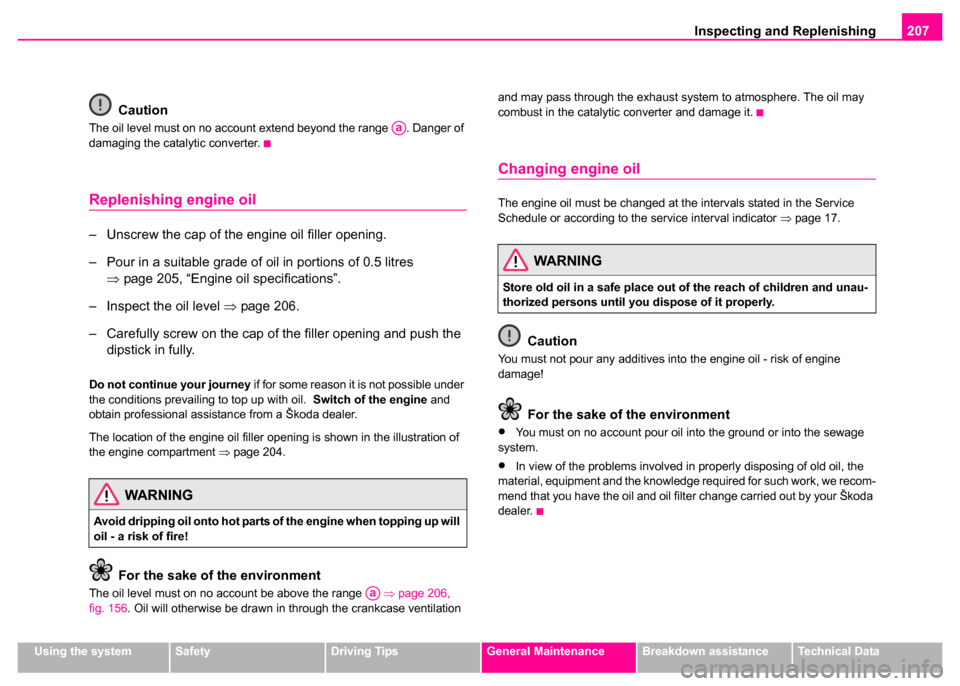
Inspecting and Replenishing207
Using the systemSafetyDriving TipsGeneral MaintenanceBreakdown assistanceTechnical Data
Caution
The oil level must on no account extend beyond the range . Danger of
damaging the catalytic converter.
Replenishing engine oil
– Unscrew the cap of the engine oil filler opening.
– Pour in a suitable grade of oil in portions of 0.5 litres
⇒page 205, “Engine oil specifications”.
– Inspect the oil level ⇒page 206.
– Carefully screw on the cap of the filler opening and push the dipstick in fully.
Do not continue your journey if for some reason it is not possible under
the conditions prevailing to top up with oil. Switch of the engine and
obtain professional assistance from a Škoda dealer.
The location of the engine oil filler opening is shown in the illustration of
the engine compartment ⇒page 204.
For the sake of the environment
The oil level must on no account be above the range ⇒page 206,
fig. 156 . Oil will otherwise be drawn in through the crankcase ventilation and may pass through the exhaust system to atmosphere. The oil may
combust in the catalytic converter and damage it.
Changing engine oil
The engine oil must be changed at the intervals stated in the Service
Schedule or according to the service interval indicator
⇒page 17.
Caution
You must not pour any additives into the engine oil - risk of engine
damage!
For the sake of the environment
•You must on no account pour oil into the ground or into the sewage
system.
•In view of the problems involved in properly disposing of old oil, the
material, equipment and the knowledge required for such work, we recom-
mend that you have the oil and oil filter change carried out by your Škoda
dealer.
WARNING
Avoid dripping oil onto hot parts of the engine when topping up will
oil - a risk of fire!
Aa
Aa
WARNING
Store old oil in a safe place out of the reach of children and unau-
thorized persons until you dispose of it properly.
Page 209 of 259

Inspecting and Replenishing
208
Cooling system
Coolant
The job of the coolant is to cool the engine.
The cooling system does not require any maintenance under normal oper-
ating conditions. The coolant consists of water with a concentration of
antifreeze agent of 40 %. This mixture not only provides antifreeze protec-
tion down to -25°C but also protects the cooling and heating system from
corrosion. It also prevents the formation of scale and significantly
increases the boiling point of the coolant.
You must therefore not reduce the concentration of antifreeze agent in the
coolant by adding water, also not during the summer months or in coun-
tries with a warm climate. The concentration of antifreeze agent in the
coolant must be at least 40%.
You can increase the amount of antifreeze in the coolant iIf a higher
concentration of antifreeze is necessary for climatic reasons but only up
to 60% (antifreeze protection down to approx. -40°C). The antifreeze
protection tails off above that concentration.
Vehicles exported to countries with a cold climate (e.g. Sweden, Norway,
Finland) are already factory-filled with a coolant which offers antifreeze
protection down to about -35°C.
Coolant
The cooling system is factory-filled with TL 774-F (G12 PLUS) coolant -
colour purple - .
We recommend that you use the same antifreeze agent - G12 PLUS
(purple in colour).
Please contact your Škoda dealer if you have any questions regarding the
coolant or if you wish to fill up with a different coolant. Your Škoda dealer can also supply you with the correct coolant additives.
Caution
•Other coolant additives may cause operational problems which,
in particular, involves significantly reducing the anticorrosion effect.
•Any faults or problems resulting from corrosion may cause a loss
of coolant and, as a consequence of this, result in major engine
damage.
Inspecting the coolant level
The coolant expansion bottle is located in the engine compart-
ment on the left.
– Switch the engine off.
Fig. 157 Engine
compartment: Coolant
expansion bottle
Page 210 of 259

Inspecting and Replenishing209
Using the systemSafetyDriving TipsGeneral MaintenanceBreakdown assistanceTechnical Data
– Open the bonnet ⇒ in “Working in the engine compart-
ment” on page 203.
– Check the level of coolant in the coolant expansion bottle ⇒fig. 157. The coolant level when the engine is cold must lie
between the “MIN” and “MAX” markings. The level may also
rise slightly above the “MAX” marking when the engine is
warm.
If the coolant level in the reservoir is too low, this is indicated by the
warning light in the instrument cluster ⇒ page 28. We nevertheless
recommend inspecting the coolant level directly at the reservoir from time
to time.
Loss of coolant
A loss of coolant is first and foremost an indication of a leak in the
system. You should not merely top up the coolant in the reservoir. It is also
important to have the cooling system inspected without delay by a Škoda
dealer.
Losses can only occur through the pressure relief in the cap of the coolant
expansion bottle which is completely free of leaks if the coolant boils as a
result of overheating and is forced out of the cooling system.
One should contact a Skoda dealer as soon as possible if the source of
overheating itself cannot be determined and removed, since there may be
grave damage to the engine.
Replenishing the coolant
– Switch the engine off.
– Allow the engine to cool down. – Place a cloth over the cap of the coolant expansion reservoir
⇒page 208, fig. 157 and unscrew the cap carefully by
turning it to the left ⇒.
– Top up the coolant.
– Screw on the cap tight until it is heard to lock.
The coolant which you use for replenishing the system, must comply with
certain specifications ⇒page 208, “Coolant”. Do not use an alternative
additive if the coolant additive G12°PLUS is not available in exceptional
cases. Just top up the system with water and as soon as possible arrange
adjustment to correct the mixing ratio of water and coolant additive again
by a Škoda dealer.
Only use fresh coolant for topping up the system.
Do not fill up over the “MAX” marking! Excess coolant which is heated up
is forced out of the cooling system through the pressure relief valve in the
cap of the coolant compensation bottle.
Wait until the engine has cooled down for a system which has suffered a
major loss of coolant before pouring in coolant. This is necessary to avoid
engine damage.
Do not continue your journey if for some reason it is not possible
under the conditions prevailing to top up with coolant. Switch off the
engine and obtain professional assistance from a Škoda dealer.
WARNING
•The cooling system is pressurized! Do not open the cap of the
coolant expansion bottle if the engine is still hot - risk of
scalding!
Page 212 of 259
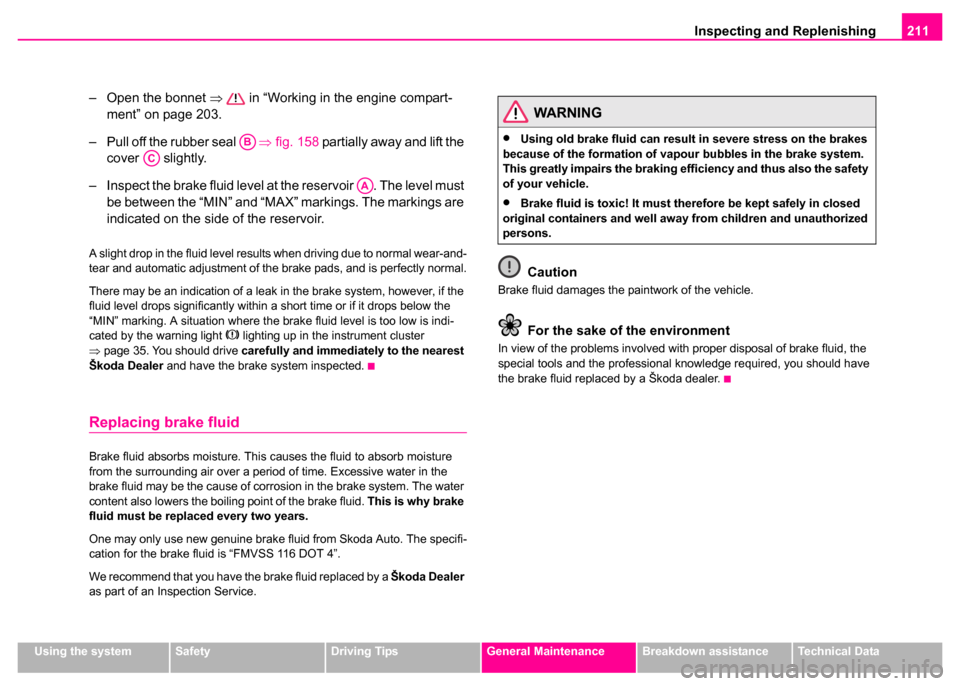
Inspecting and Replenishing211
Using the systemSafetyDriving TipsGeneral MaintenanceBreakdown assistanceTechnical Data
– Open the bonnet ⇒ in “Working in the engine compart-
ment” on page 203.
– Pull off the rubber seal ⇒fig. 158 partially away and lift the
cover slightly.
– Inspect the brake fluid level at the reservoir . The level must be between the “MIN” and “MAX” markings. The markings are
indicated on the side of the reservoir.
A slight drop in the fluid level results when driving due to normal wear-and-
tear and automatic adjustment of the brake pads, and is perfectly normal.
There may be an indication of a leak in the brake system, however, if the
fluid level drops significantly within a short time or if it drops below the
“MIN” marking. A situation where the brake fluid level is too low is indi-
cated by the warning light
lighting up in the instrument cluster
⇒ page 35. You should drive carefully and immediately to the nearest
Škoda Dealer and have the brake system inspected.
Replacing brake fluid
Brake fluid absorbs moisture. This causes the fluid to absorb moisture
from the surrounding air over a period of time. Excessive water in the
brake fluid may be the cause of corrosion in the brake system. The water
content also lowers the boiling point of the brake fluid. This is why brake
fluid must be replaced every two years.
One may only use new genuine brake fluid from Skoda Auto. The specifi-
cation for the brake fluid is “FMVSS 116 DOT 4”.
We recommend that you have the brake fluid replaced by a Škoda Dealer
as part of an Inspection Service.
Caution
Brake fluid damages the paintwork of the vehicle.
For the sake of the environment
In view of the problems involved with proper disposal of brake fluid, the
special tools and the professional knowledge required, you should have
the brake fluid replaced by a Škoda dealer.
AB
AC
AA
WARNING
•Using old brake fluid can result in severe stress on the brakes
because of the formation of vapour bubbles in the brake system.
This greatly impairs the braking efficiency and thus also the safety
of your vehicle.
•Brake fluid is toxic! It must therefore be kept safely in closed
original containers and well away from children and unauthorized
persons.
Page 220 of 259
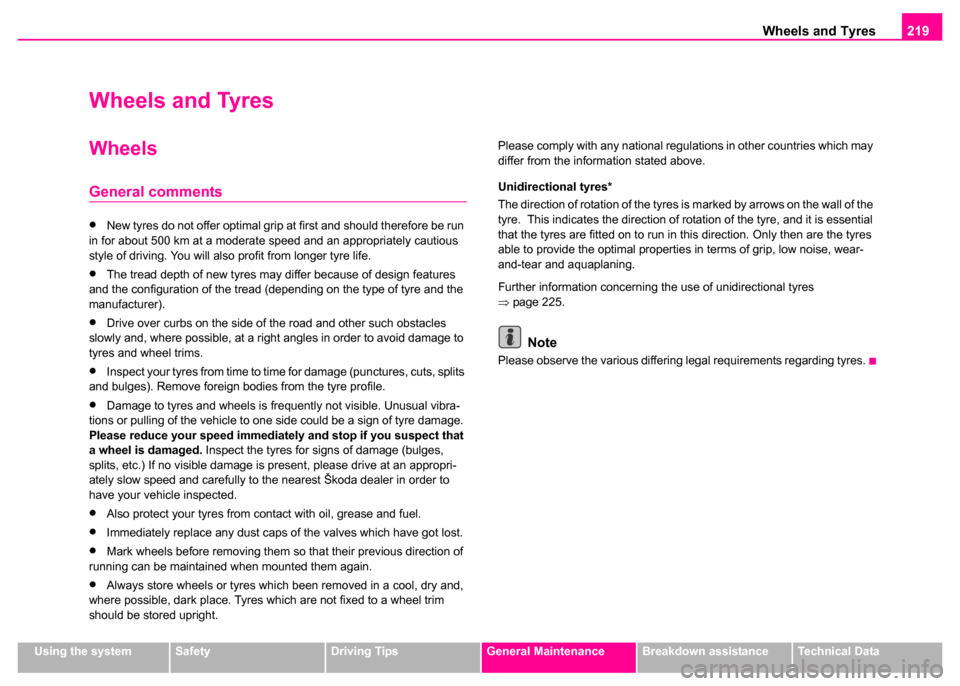
Wheels and Tyres219
Using the systemSafetyDriving TipsGeneral MaintenanceBreakdown assistanceTechnical Data
Wheels and Tyres
Wheels
General comments
•New tyres do not offer optimal grip at first and should therefore be run
in for about 500 km at a moderate speed and an appropriately cautious
style of driving. You will also profit from longer tyre life.
•The tread depth of new tyres may differ because of design features
and the configuration of the tread (depending on the type of tyre and the
manufacturer).
•Drive over curbs on the side of the road and other such obstacles
slowly and, where possible, at a right angles in order to avoid damage to
tyres and wheel trims.
•Inspect your tyres from time to time for damage (punctures, cuts, splits
and bulges). Remove foreign bodies from the tyre profile.
•Damage to tyres and wheels is frequently not visible. Unusual vibra-
tions or pulling of the vehicle to one side could be a sign of tyre damage.
Please reduce your speed immediately and stop if you suspect that
a wheel is damaged. Inspect the tyres for signs of damage (bulges,
splits, etc.) If no visible damage is present, please drive at an appropri-
ately slow speed and carefully to the nearest Škoda dealer in order to
have your vehicle inspected.
•Also protect your tyres from contact with oil, grease and fuel.
•Immediately replace any dust caps of the valves which have got lost.
•Mark wheels before removing them so that their previous direction of
running can be maintained when mounted them again.
•Always store wheels or tyres which been removed in a cool, dry and,
where possible, dark place. Tyres which are not fixed to a wheel trim
should be stored upright. Please comply with any national regulations in other countries which may
differ from the information stated above.
Unidirectional tyres*
The direction of rotation of the tyres is marked by arrows on the wall of the
tyre. This indicates the direction of rotation of the tyre, and it is essential
that the tyres are fitted on to run in this direction. Only then are the tyres
able to provide the optimal properties in terms of grip, low noise, wear-
and-tear and aquaplaning.
Further information concerning the use of unidirectional tyres
⇒
page 225.
Note
Please observe the various differing legal requirements regarding tyres.